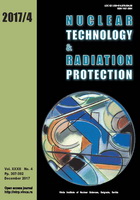
EFFECTS OF GAMMA RADIATION INDUCED FORCED FORMATION OF FREE RADICALS ON THE STRENGTH OF CONCRETE FOR USE IN NUCLEAR POWER PLANTS

Vol.
XXXII, No. 4, Pp. 307-392
December 2017
UDC 621.039+614.876:504.06
ISSN 1451-3994
Pages: 307-319
Authors: Steven Burnham, Quentin Faure, Michelle Tamplin, Long Huang,
and Tatjana JevremovicAbstract
In this paper, we present a summary of preliminary experiments and numerical assessments of the effects of gamma radiation induced formation of free radicals in the curing stage of concrete on its characteristics. Substantial literature reports on the damaging effects of long-term and high-dose gamma and neutron exposure on concrete. However, we show that short-term exposure of concrete to gamma radiation can be beneficial in increasing its compressive strength. The effects of exposing to 630 MBq 137Cs the 56 cubes each made of 125 cm3 concrete during the first seven days of curing are compared to another 56 cubes cured by the conventional process. The average compressive strength of the gamma cured cubes is around 8.500 psi, while conventionally cured cubes show the lower average strength of around 6.700 psi. The microstructure of the gamma and conventionally cured concrete cubes is analyzed using a scanning electron microscope. The radiolysis within the microstructure of the concrete cubes is assessed with computational modeling based on Geant4. The production of free radicals from radiolysis is shown to increase with increasing source strength and increasing the time of exposure to gamma radiation. This research shows in general that curing concrete in gamma radiation field provides observable trends toward its increased strength.
Key words: concrete for nuclear industry, nuclear concrete strength, Geant4, gamma radiation
FULL PAPER IN PDF FORMAT (1.9 MB)